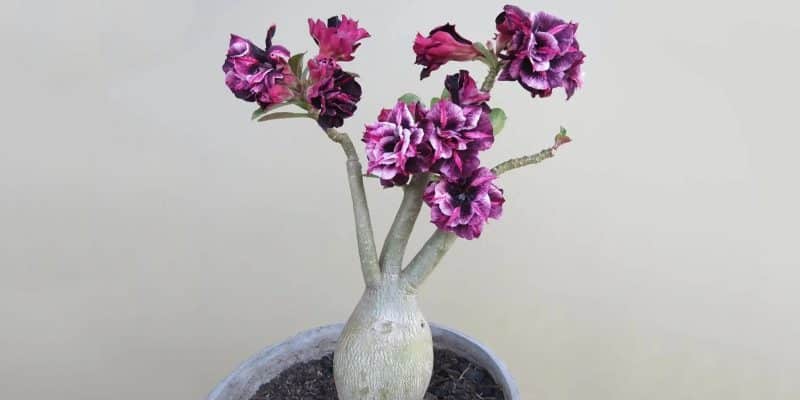The Desert Rose plant, known for its stunning, trumpet-shaped flowers and plump, succulent stems, can instantly transport you to a world of sun-kissed sands and vivid colors.
So, whether you’re an experienced gardener or just starting out on your plant collecting journey, we’ll take you through everything you need to know about Desert Rose plant care, from watering and soil requirements to sunlight and temperature preferences.
Table of Contents
Desert Rose Plant Care Guide
History, Habitat, and Characteristics
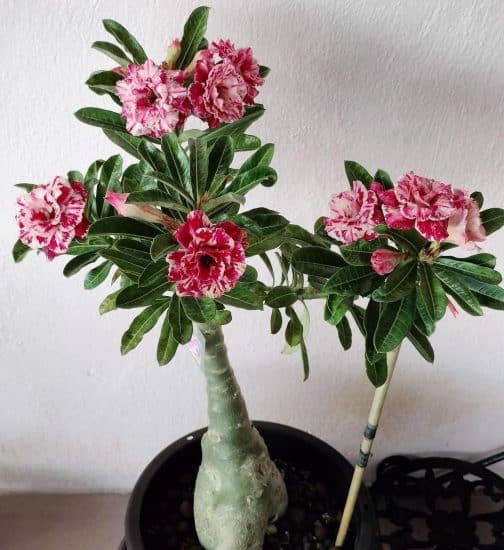
Hailing from the desert-like regions of North Africa and the Middle East, including the Arabian Peninsula, desert rose (Adenium obesum) is a sun-loving plant that’s well adapted to hot, arid environments. But don’t let its desert origins discourage you. You can grow Desert Rose indoors easily.
The Desert Rose is a slow-growing plant from a subgroup of the dogbane family (Apocynaceae) with a unique, bonsai-esque growth habit. It also has a striking, twisted caudex — a swollen, water-storing trunk that gives it a sculptural appeal.
Its five-petaled blooms, which come in various shades of vibrant pink, red, and white, provide a stunning contrast against its narrow green leaves.
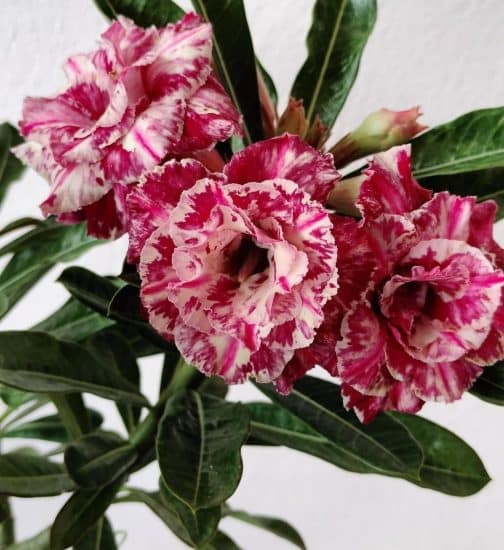
Unlike most succulents, Desert Rose is a deciduous plant, meaning it will drop its leaves after the growing season. If you observe this behavior in your desert rose, it’s not necessarily a sign of distress or poor care. It’s just its natural habit.
While you can grow Desert Rose in most conditions, it’s important to note that its sap is poisonous and can be fatal if ingested. In fact, it’s even been used for hunting purposes in parts of Africa. However, traditional cultures have also used other parts of the same plant for medicinal purposes for centuries.
Fun fact: You may see Desert Rose referred to as mock azalea. It’s called mock azalea because of its similar leaves and flowers, but a closer look reveals they’re really not all that similar. Azaleas have a bushier growth pattern and less defined petals, and they also lack the bulbous, swollen stem of the Desert Rose.
Light
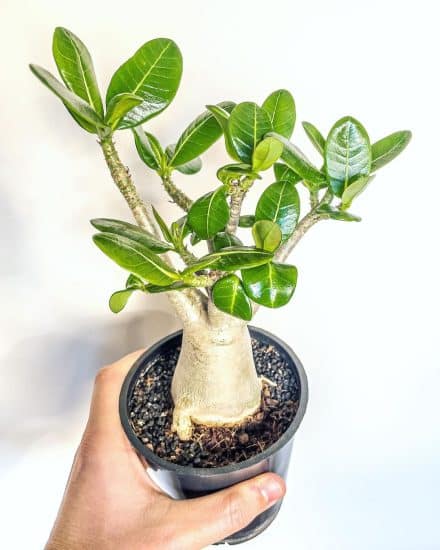
Given the arid origins of Desert Roses, these succulent plants thrive in bright light. Make sure yours receives at least 6 hours of direct sunlight each day for proper growth and plenty of flowers. For those in warmer climates, moving it outside during the growing season can help it get enough sunlight to bloom.
If your Desert Rose isn’t getting enough light, you might notice slow growth, lanky stems, or leaning toward light. It’s also unlikely to bloom without sufficient exposure to bright light. If you notice any of these signs, move it closer to a south-facing window if you keep this plant indoors, or out of the shade if you have it outside.
However, even a sun-loving plant can get too much sun. Excessive direct sunlight can burn your Desert Rose’s delicate leaves, which may look bleached or develop small holes. In such cases, give it a bit of shade during the hottest part of the day.
Our lighting tips:
- Provide Desert Rose with bright light.
- In the growing season, move the plant outdoors to soak up 6 hours of direct sunlight daily.
- If you can’t give your plant enough bright light, use artificial light (like an LED full-spectrum grow light) to supplement the natural sunlight.
Water
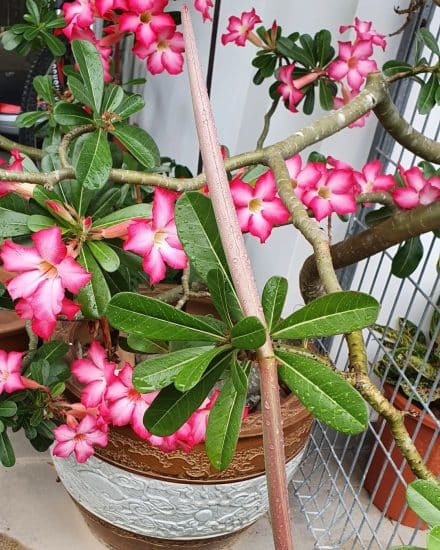
Let the soil dry out before you water your Desert Rose plant. The plant stores water in its succulent trunk, so it’s easy to overwater. Make sure to touch the soil to check for dryness, and use a well-draining soil and a pot with a good drainage hole. Keep an eye on the leaves as well for signs of over- or underwatering.
If your Desert Rose starts wilting, its leaves turn brown and crispy, or you notice leaf drop, it’s sending you a message: “Hey, friend, I need more water!” When you water, do so thoroughly, allowing water to flow from the drainage holes. Then wait for it to dry out again.
On the flip side, too much water can lead to rotted or dead roots and a lack of flowering. Overwatering symptoms include yellowing leaves, soft and mushy stems, and no blooms in sight. In this case, let the plant dry out more before your next watering session.
Our watering tips:
- Water thoroughly during the growing seaso, but only when the soil is dry.
- Cut back on water during the winter season.
- To avoid overwatering, use a well-draining soil and a pot with drainage holes.
Temperature and Humidity
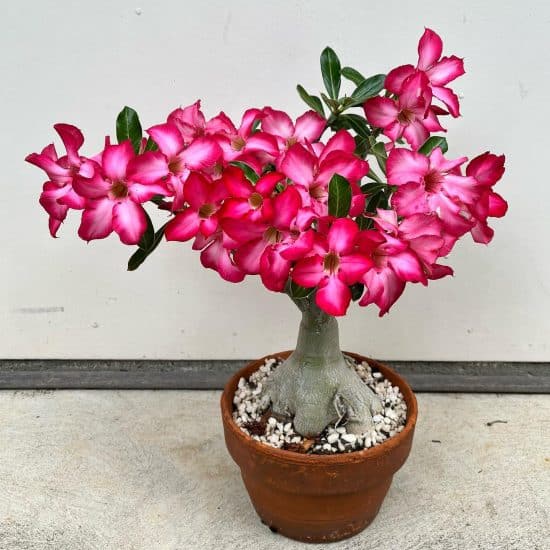
The Desert Rose plant appreciates warmer temperatures, so aim for temperatures between 65-80°F (18-27°F). Especially in cooler zones, keep your plant indoors in the winter. When temperatures drop in autumn, be cautious of cold temperatures from drafty windows and doors, which can shock and damage desert plants.
Desert Rose plants come from dry environments, so they don’t need high humidity. An average household humidity between 40% and 60% is fine for Desert Rose, just like other succulent plants. If the leaves start to droop or the tips turn brown, this could be a sign that the humidity level is too low, but this is unlikely. Yellowing leaves, however, may indicate excessive humidity.
Soil and Planting
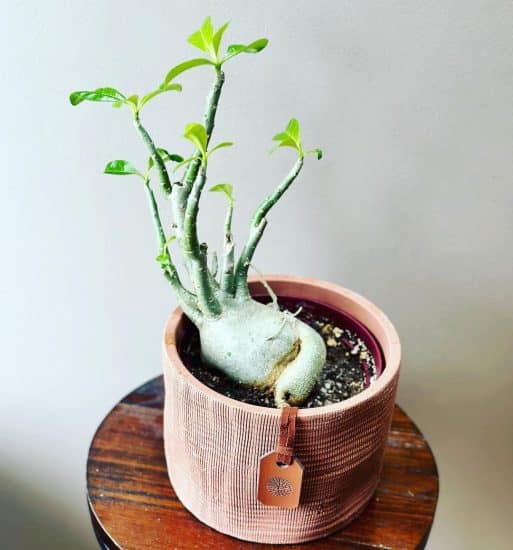
As a succulent plant from desert regions, Desert Rose needs a well-drained soil. Use a mix of at least 50% sand or perlite combined with potting soil. When it’s ready for a new pot, select a shallow one to encourage a thick caudex. Adding compost will strengthen the roots and help your Desert Rose plant flower during the growing season.
Signs of an unsuitable potting mix may include yellowing leaves, stunted growth, and a lack of desert rose blooms. If you don’t add enough elements that increase drainage, the soil will retain too much moisture. Ensure that the soil mixture contains sand, perlite, or some other gritty element.
Fertilizer
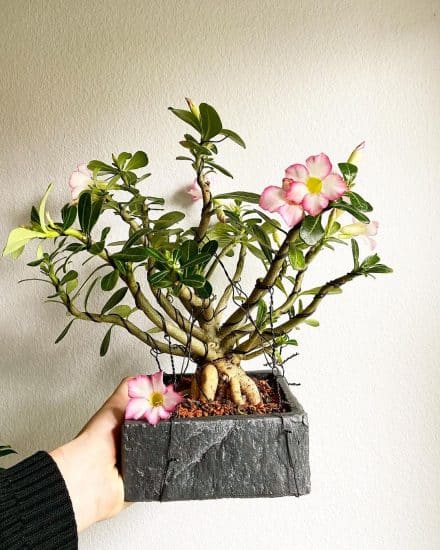
While fertilization during the growing season may be essential for the growth of your Adenium obesum Desert Rose, applying too much can damage your plant.
Signs of over-fertilization include yellowing leaves, soft and mushy roots, burned foliage, or a sudden decline in the plant’s overall health. To resolve these issues, reduce the frequency and strength of the fertilizer applications. Ensure that the fertilizer is diluted appropriately, and don’t fertilize your desert rose plant during its dormant period.
Propagation
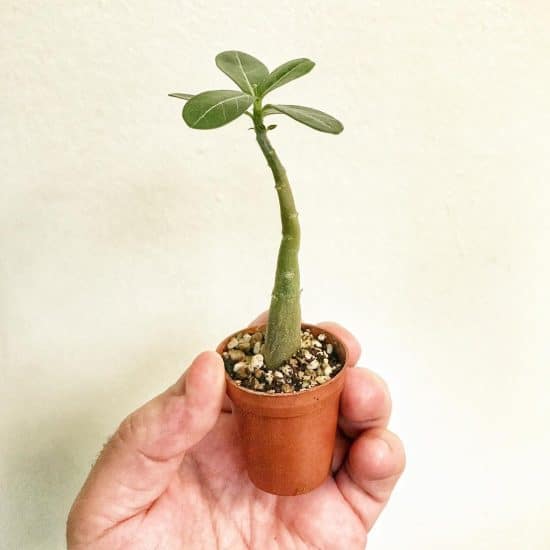
Ready to learn how to grow a new Desert Rose without breaking the bank? We’ve got a step-by-step guide to help you propagate your plant from seeds.
Propagating Desert Rose by seed:
- Harvest fresh adenium seeds from a mature plant. The best time to snag seeds is when the seed pods are about to split open in early spring. After you collect the seeds, give them a quick coat with an antifungal powder to keep fungus away.
- Whip up our recommended potting mix. A well-draining soil mix will make sprouting a breeze for your seeds.
- Sow the seeds in your preparent soil. Gently place them on the surface and then give them a light dusting with potting soil. Don’t bury them too deep or they might not grow.
- Spritz or lightly water your seeds once every two days, keeping the soil moist but not saturated. You can add an antifungal to this water to prevent issues with rot.
- Patience is key. Your seeds should germinate within 7 days, and after 3 or 4 weeks you’ll begin to see new growth.
- Plant your seedlings. Once they hit the 2-month mark, it’s time to move your little ones into their own individual pots.
Our propagating tips:
- Go for the freshest seeds you can find to boost your chances of successful germination.
- Keep your seedlings warm, with plenty of light, but shield them from too much direct sunlight.
- Remember, growing desert roses from seeds takes time, so be patient and keep at it.
Common Issues
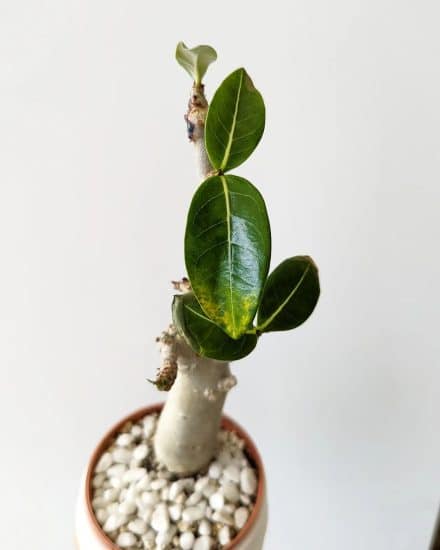
Part of good Desert Rose care sometimes means dealing with issues like focal rot or soft stems. We’ll tell you how to identify and treat them.
Focal Rot
Focal rot just means rot in one specific place. It occurs in Desert Rose when the stem or caudex starts to deteriorate from the point of an injury. You’ll spot this issue by the dark, mushy, and damp area on the injured part of your plant’s stem.
To remedy focal rot, grab a sterile cutting tool and carefully trim away the rotten section. This will stop the rot from spreading to the healthy parts of your plant. Just give the remaining healthy part some time to dry and heal before watering it again, and double-check that there’s proper drainage.
Soft Stems
Soft and possibly discolored or mushy stems could be the result of a lack of nutrients in your Desert Rose plant’s soil, among other issues.
First things first, make sure your plant has good drainage and isn’t sitting in standing water. By allowing the soil to dry out properly between waterings, you can avoid moisture-related problems that plague many plants, including Desert Roses.
Another thing to consider is your plant’s nutrient content. Apply a slow-release fertilizer for stronger stems and overall health. And if the problem persists, it might just be time to repot your Desert Rose in some fresh soil with better drainage and balanced nutrients.
Pests and Diseases
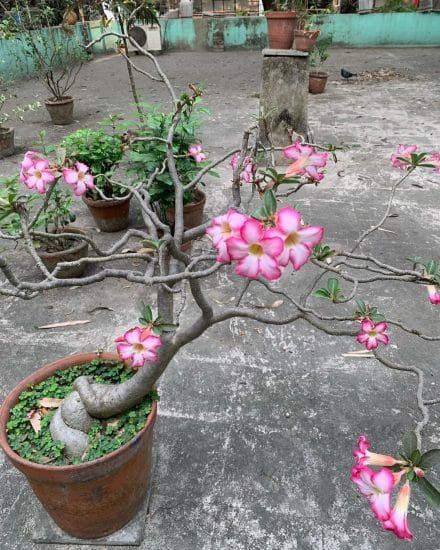
Insects can also challenge your Desert Rose care abilities, especially since some are big fans of the dry air this plant thrives in. But don’t worry — there are simple ways to get rid of them.
Aphids
When aphids attack your Desert Rose plant, the leaves might look yellow and misshapen, and there could be a sticky residue on the surface called honeydew. They’re most common during warm weather, but depending on your location, they can be a year-round problem.
First, isolate your plant from any other houseplant to avoid spread. Use a damp cloth to gently wipe off as many of the aphids as possible. Then, apply a mixture of neem oil and water, or if you prefer, a solution of dish soap and water. Spray your Desert Rose desert rose plant with whichever mix you choose, and repeat weekly until you give those aphids the boot.
Spider Mites
Spider mites are the most common type of pest you might catch bothering your Desert Rose. This is because both Desert Rose and spider mites like dry air.
You can recognize spider mites by the thin webbing they create around the leaves and stems of your plant. Mitigation is the same as for aphids. Wipe off as much of the visible infestation as you can and apply a neem oil or dish soap mixture. Pay close attention to the plant in the future to catch this problem right away.
Root Rot
When a plant’s roots sit in standing water or damp soil, the roots will rot. If your Desert Rose plant’s leaves are turning yellow or dropping, or if you spot cortex pimples and a soft cortex or branches, rot might be the culprit. Take your plant out of its pot and have a look at the roots. If the roots are dark, slimy, and mushy, you’ve got the rot.
Using sterilized scissors, trim away the damaged roots until you reach healthy root tissue. Then, repot your desert rose plant in fresh, well-draining soil with plenty of perlite, pumice, or LECA added for extra aeration and drainage. Let the soil dry out before watering again, and your plant should be on the road to recovery.
Drainage holes are absolutely essential to preventing root rot. You should never put any plant in a pot without drainage holes, but especially succulent plants.
Powdery Mildew
Powdery mildew is usually caused by a fungus, Podosphaera xanthii. The first signs are usually little blisters on your Desert Rose plant’s leaves, followed by a thin, white film or spots. The most common cause is high humidity and poor circulation.
The best remedy for powdery mildew is applying a fungicide. Be sure to follow the instructions on the label because misapplying any plant treatment can damage your plant. For an eco-friendly fungicide, you can try sulfur, just be careful about using it when the weather is very hot.
Conclusion
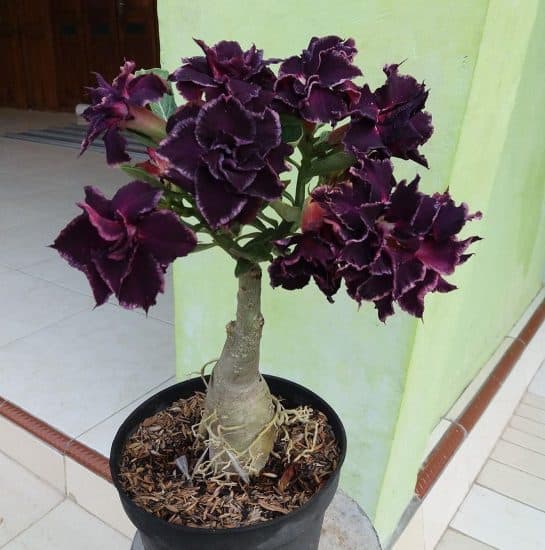
And there you have it, our comprehensive guide to the Desert Rose! Adenium obesum is an exquisite addition to any indoor garden, not only for its stunning appearance, but also for its resilience.
Desert Rose plant care summary:
- Provide at least 6 hours of direct sunlight to encourage flowering, moving the plant outdoors during warmer months if necessary.
- Water thoroughly when the soil is almost completely dry, and reduce watering even more during the winter.
- Make sure indoor temperatures stay between 65°-80°F and maintain a humidity level no higher than 40%-60%.
- Use well-draining soil with a mix of sand or perlite, as well as a container with proper drainage holes.
We hope our Desert Rose plant care guide has been helpful. If you have any questions or need further assistance, don’t hesitate to reach out to us! And if you enjoyed this article, be sure to share it with fellow plant lovers.
Happy growing!
FAQ
How do you keep a Desert Rose blooming?
To keep your Desert Rose plant blooming, start by making sure it gets ample sunlight. These desert plants need at least 6 hours of direct sun every day. During the summer months, place your plant outdoors to encourage the trumpet-shaped flowers to come out and play.
Another crucial aspect is careful watering and good drainage. Desert Roseenjoys a good soak, but it’s crucial to let the soil dry out completely between waterings. Over-watering can lead to a number of problems that will prevent flowering.
Is Desert Rose a bonsai plant?
Although it may not be a traditional bonsai, the desert rose plant indeed shares some striking similarities with these mini, sculptural trees.
Renowned for its charming, bonsai-esque growth habit and striking caudex (that swollen, water-storing trunk), the Desert Rose can serve as an excellent, low-maintenance alternative to traditional bonsai plants. With a little pruning and shaping, you can train your Desert Rose into a stunning, bonsai-like masterpiece.
Is Desert Rose an indoor or outdoor plant?
Both! Desert Rose plant can thrive both indoors and outdoors. As an indoor plant, the desert rose requires a bright window with at least 6 hours of direct sun every day. A south-facing window is your best bet.
When outdoor temperatures rise and the sun is shining bright, feel free to move your Desert Rose outside to soak up the rays. Just remember that it might need to acclimate to the change in temperature and light, so introduce it to the outdoors gradually. And when cooler months roll around, bring your Desert Rose inside to protect it from the cold.

